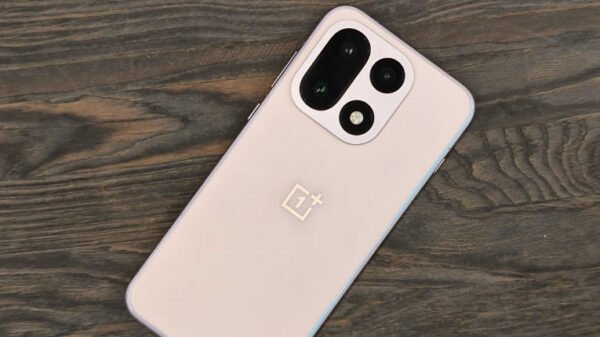Verdict
The OnePlus 15 doesn’t reinvent the wheel — it perfects the drive. With the Snapdragon 8 Gen 5, an enormous 7300mAh battery, and a refined design that feels delightfully premium, the OnePlus 15 continues the brand’s tradition of balanced excellence. The camera setup is more dependable than dazzling, the performance is class-leading, and battery life is borderline insane. Where it falters is in the small things, the missing Hasselblad partnership, the outdated charging cable, and a few software quirks. But those are nitpicks in what is otherwise one of the most cohesive flagship experiences of the year.
The Good
- Outstanding battery life
- Unblemished performance
- Refined design
The Bad
- Camera lacks the extra magic
- Minor software quirks
-
Design
-
Display
-
Sound
-
Camera
-
Performance
-
Battery Life
-
Software
There’s something about a new-gen OnePlus smartphone that still gets one excited. And this stands especially true for those who’ve been following the brand’s journey from its inception. Back when the OnePlus One was launched, the euphoria surrounding its high-end offerings at what was then a mid-range price tag, along with, of course, the fact that it was an invite-only device to buy, made it quite the talk of the town. Fast forward to now, and the OnePlus 15 isn’t as big a diamond in the rough as its progeny was, but it’s still something exciting.
OnePlus has ditched the Hasselblad branding this year for reasons unknown, but has stuck to adopting the bleeding edge in chipset tech, the Snapdragon 8 Gen 5 SoC. Priced at ₹72,999, the phone has adopted a rather massive 7,300mAh battery, which holds huge promise. And then there are plenty of other aspects like its cameras, new software features, and more that make you want to delve deep inside its offerings. And I’m here to do just that.
Design

I have to admit. I had been privy to the OnePlus 15 even before the device had arrived at our doorstep. At a recent event in Goa, during a conversation with Robin Liu, he had graciously allowed me to check the device out on the grounds that I couldn’t take any pictures of it. I obliged, and the first thing I noticed was the uniqueness of the device’s frame. It was something new; something so unique that it surprised me that no other device had managed to give me the same feel despite the sea of smartphones I’ve used to date. This frame felt like aluminium, but it also felt like sandstone, and somehow, it also felt blissfully cold. And all this while offering excellent grip.
It was the Sand Storm variant that Robin had on him then, and the process used on that frame was called Micro Arc-Oxidation (MAO). Imagine my disappointment on finding out that this surface is not part of the phone’s other colourways. And imagine my further disappointment when I found out that OnePlus had sent across the Ultra Violet variant to me, instead of the Sand Storm. Alas, but life goes on. The Ultra Violet model, too, has a pretty grippy aluminium frame. The glass on its back is completely matted out and delivers a rather smooth touch. Its colour is subtly dynamic, in the sense that it shifts slightly depending on the amount of light falling on it.
Speaking of the camera module, unsurprisingly, it’s shaped the same way you’d expect it to be shaped. The iPhone aesthetic is going to be everywhere; we have to expect that. Thankfully, though, the arrangement of the sensors is pretty different here. A vertical capsule houses two sensors, while two individual housings are reserved for the third sensor and the flash. Flip the OnePlus 15 over, and you find a neat 6.78-inch display tucked beautifully into a shell that has uniform bezels on all four sides, and these are, somehow, just 1.15mm thin. That’s an engineering feat right there.
On the left, the OnePlus 15 houses a new Plus Key, the functionality of which I’ll speak about later on in this review. In terms of durability, the OnePlus 15 has taken a pretty robust approach. Its aluminium and glass ‘jugalbandi’ should ensure that there’s top-notch protection on offer for shielding it from daily wear and tear. Plus, there’s Gorilla Glass Victus 2 at the front, which is another boon. Its durability receives a further boost through its IP69 and IP69K ratings. What does the latter mean? It’s basically protection from high-pressure water jets at temperatures of up to 80 degrees Celsius. I doubt one’s gonna put their handset through such a scenario, but what it translates to in real-world use is that I can unflichingly, unabashedly and unbotheredly use it underwater.
Display and Sound

OnePlus is calling this the industry’s first 1.5K resolution panel with a 165Hz refresh rate. The 6.78-inch LTPO AMOLED display isn’t the brightest around. In fact, it goes up to 800 nits typically and up to 1800 nits in HBM. But that certainly doesn’t kill its vibe by any means. Watching movies and TV shows on it is a highly satisfying experience thanks to the rich colours and deep blacks. What’s evident is that OnePlus has geared this panel towards gamers. The 165Hz nature translates into low latency and high frame-rate gaming. In fact, supporting titles like Real Racing 3 can natively offer 165 fps support, which is a huge deal. And if you’re a PUBG person, rest assured that the same will also be available to you, albeit using frame interpolation.
Coming to its dual stereo speakers, they are pretty ideal for daily use. Your Reels will sound excellent at all volumes, and so will your games. Even if you’re going to watch movies and TV shows on it, you’ll definitely be very satisfied with the output.
Camera

Three 50MP cameras sit on the back of the OnePlus 15. Let’s start with the main sensor. It’s a 50MP Sony IMX906 unit that handles most of the workload and focal lengths, whether you’re at 1x, 2x, 3.5x, or 7x, with the 50MP portrait camera taking over only when 3.5x portraits are needed. And then of course, there’s another 50MP lens for ultra-wide shots. But as always, the purpose of this entire assembly is also to serve up incredible digital zooming capabilities. In that regard, the OnePlus 15 manages to stretch up to 120x. Needless to say, though, that pushing it this far is a futile exercise. The images, clicked at 120x, look like digital paintings of the actual scene, and are absolutely not usable. At 100x, the sharpening is a little less artificial, but it still can’t match the AI brilliance of the Pixel 10 Pro’s Pro Res Zoom.
Photographs clicked from the OnePlus 15 are the beneficiaries of the company’s new DetailMax Engine, which is described as an “advanced suite of computational algorithms that work in concert.” This enables an Ultra Clear 26MP mode that excels at capturing minute details for large prints. I found this mode to add little value to all the photographs I clicked, after comparing them with images clicked in the regular resolution. The impressive aspect of the DetailMax Engine is its Clear Burst feature, which shoots an impressive 10 photos per second with dual exposure anti-blur technology. During a trip at the Buddh International Circuit recently, I was able to test this feature out on a roaring fast Skoda Octavia RS and was left thoroughly impressed at how well it worked to freeze the frames despite the subject being so fast-moving.
Which brings us to the low-light performance of the OnePlus 15’s cameras. The main camera is the best choice here, and the results are gratifying but not extraordinary. Colours are captured very earnestly, but the details in the shadows take a hit, more often than not. I guess that’s due to the heavy focus on reducing noise that the DetailMax Engine is geared towards. And when the light is good, the OnePlus 15 does a splendid job. Daytime shots are replete with detail and sharpness, although HDR can get aggressive at times, but it doesn’t end up spoiling the photos much.
HDR support is available in videos as well, along with the full Dolby Vision branding. I was pretty happy with the video output of the device, and the fact that I could shoot 4K 120fps with Dolby Vision gave me immense independence to go ahead and shoot professional-grade footage that I could turn into cinematic pieces on the edit table. In conclusion, the OnePlus 15’s camera setup feels mature and purpose-built rather than gimmicky. It may not dethrone the Pixel or iPhone in computational wizardry, but it brings its own flavour of precision and versatility. The DetailMax Engine is genuinely useful for motion-heavy scenes, and the triple 50MP array delivers consistent results across focal lengths when lighting is on your side.
Performance

Apart from being the first phone in India to cushion the Snapdragon 8 Gen 5 chip inside it, the OnePlus 15 has also adopted a proprietary tuning algorithm that it calls the OnePlus CPU Scheduler. It’s a resource allocator, which intelligently directs CPU power to the tasks at hand. In gaming, this results in consistent 120fps framerates in games that support it. To handle the heating issues that can arise due to this, the phone uses 360 Cryo-Velocity Cooling. In the real world, unsurprisingly, I was extremely pleased with this device’s performance.
Gaming was silky smooth, whether I dabbled in the 120fps-supporting BGMI or the 165fps-supporting Real Racing 3. Despite long sessions in both games, I barely noticed any frame-rate drops. This, coupled with the power of a dedicated touch response chip, made the gaming experience extremely pleasing. And there’s no question of everyday performance. The interface feels absolutely buttery smooth, no matter how much you push the phone’s resources to the maximum. At one point, I tried juggling between the two aforementioned games multiple times, and the phone easily allowed me to switch between them without any hiccups.
Battery life

The OnePlus 15’s battery system is easily one of its biggest talking points. With a massive 7300mAh Silicon Nanostack cell, OnePlus has gone beyond the regular “big battery” trope. This isn’t just about sheer capacity; it’s about energy density and efficiency. The new silicon-based chemistry allows for a thinner design without compromising on capacity, meaning you get long endurance without a bulky body. In terms of capacity, I stretched this phone to 2 days almost every cycle. It was only when I indulged in a bit of gaming here and there that I had to make do with 1.5 days of usage. And there was even an instance when, while travelling on a work trip of 3 days, I didn’t charge the device even a single time. That’s an insane amount of battery life at your disposal.
Charging, of course, is pure OnePlus magic. The 120W SUPERVOOC charger remains a marvel. Plug in for 10 minutes and you’re good for nearly a day. And when you’d rather go wireless, the 50W AIRVOOC support is equally impressive. Add Bypass Charging to the mix, and it’s clear that OnePlus has fine-tuned both speed and longevity. That said, there’s one gripe that’s hard to ignore: the charging cable. It’s still a Type-A to Type-C design in 2025, which is a decision that feels both dated and frustrating. When everything from laptops to mid-range Androids has moved to Type-C-to-C for faster, universal compatibility, OnePlus sticking to its proprietary setup feels like clinging to the past.
Software
OxygenOS 16 brings a couple of interesting additions. Among them is the functionality of the Plus Key that’s placed where the Alert Slider would have been placed, had OnePlus not decided to axe it for some ungodly reason. In terms of its functionality, it’s very similar to that of the Essential Key in Nothing’s recent offerings. It takes a screenshot of whatever’s on the screen and places it in an area called Mind Space, after archiving it based on the contents of the screenshot. The idea is that instead of making quick notes, you just take screenshots and forget about them. When you wish to remember that stuff later, you can enter Mind Space and just do a quick search with keywords included in the screenshot.
It’s clever, but it’s a feature no one asked for, and another one among the many “AI” integrations that are unnecessary. What’s good is that Mind Space is Gemini-powered, so detailed information is supported as well. But honestly, this feature never worked as advertised, and I found that making old-school notes on Google Keep was a much better alternative. There are plenty of other AI-based features integrated into the software, and there’s nothing new to talk about. In terms of UI, OxygenOS 16 continues to be attractive and intuitive, but a few things did bother me. For some reason, the Live captions feature was on by default and threw captions on my Reels, covering almost 30 percent of the area. I had to dig through settings to turn it off. Also, and this too happens by default until you turn it off, when sharing things from another app to WhatsApp, WhatsApp opens in windowed mode. Why not let the user decide, OnePlus?













1 Comment
Pingback: iQOO 15 Review: Flagship Power Without the Premium Price Tag